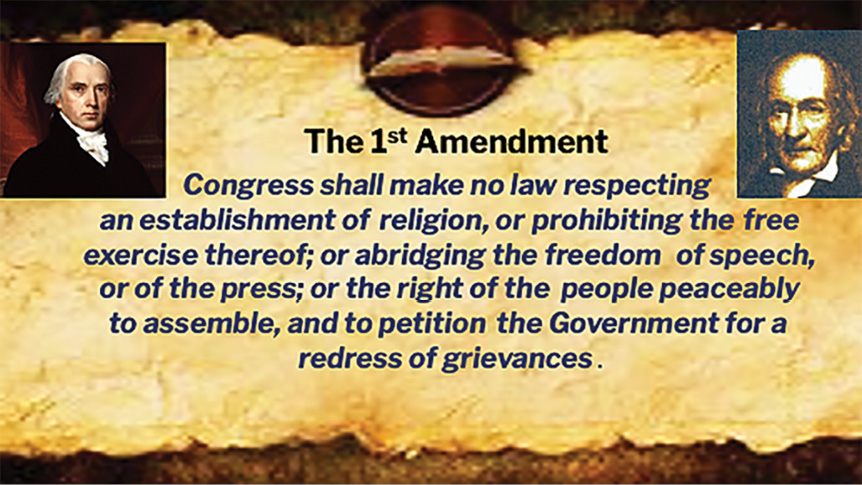Passing of the Amendment
Here we are at the culmination of our five-part series. We started with Granby’s Congregational church life and added the Connecticut River Valley’s Great Awakening, plus the church’s harsh response. This awakening moved to the Southern colonies, resulting in yet harsher persecution by the Episcopal Church of Virginia. Madison and Jefferson were instrumental in the Virginia Declaration of Rights in 1776, but how did their religious freedom idea get to be the First Amendment to the Constitution in 1789, 13 years later?
Madison’s relationship with John Leland (the Baptist evangelist from part four) continued throughout the Revolutionary War, and played a key role in this amendment. The nation’s Constitutional Convention in 1787 was in a debate—would it have a strong central (federalist) government, or should government be strongly invested in the states? One key resolution was the Connecticut Compromise of the two branches of Congress (House and Senate) that we have today. By September, the US Constitution was published with a ratification convention to occur in 1788.
In Connecticut, Granby’s pastor was Isaac Porter, a strong fire and brimstone Calvinist. Gone were the peaceful days of Pastor Joseph Strong. Porter came from Yale and was mentored under Timothy Dwight, then president of Yale. Porter greatly feared that Jefferson’s enlightenment thinking was a gateway for atheists. He defended the state church concept of imposed religion so that people would not be derelict in morality.
Virginia was a key state and hotbed for the debate between Madison the federalist and Patrick Henry the antifederalist. As such, the election of representatives to the Ratification Convention was significant. The heart of the debate was in Orange and Culpeper counties, where the persecution occurred some thirty years earlier. Starting in 1783, those same churches formed Baptist Associations with the head being John Leland, a close friend of Madison the federalist. Yet Leland was an advocate for antifederalist individual freedom of conscience.
Mark S. Scarberry’s 2009 Penn State Law Review paper, Religious Influence on the Ratification of the Constitution and on the Proposal of the Bill of Rights, details the Madison-Leland relationship, letters, meetings and the events that transpired. The two antifederalist Baptist counties ironically voted for a landslide victory for the federalist Madison. This occurred not once, but twice. First, electing Madison to the Ratification Convention to approve the Constitution. Secondly, Madison was elected to the first Congress. This enabled him to propose the First Amendment, only three months after the first Congress started. By it, he also fulfilled a promise to Leland and the Baptist Associations for the freedom of conscience. Scarberry also notes that, “It is good to read The Writings of the Late Elder John Leland to understand the context for the intent of the language used.”
An outsider’s perspective on the American experiment is in order. In 1840, the French historian, Alex De Tocqueville, wrote the oft-quoted perspective, Democracy in America. “In the United States, religion governs not only behavior but extends its influence to men’s minds…Thus while the law allows the American people to do everything, religion prevents their imagining everything and forbids them from daring to do everything.” His point is that the government of America and its liberty functioned properly because of the restraint of religion on the conscience, though not legislated. It also implies that the founders were not atheists but believed in a creator God of providence of “inalienable rights.”
In conclusion, there are some history lessons from this series:
The Congregational and Episcopal State Churches proved that you can’t legislate belief. This is a pattern repeated throughout history, no matter what religion.
The true history of the First Amendment must include the influence of religion. Religious persecution and John Leland’s freedom of conscience teaching plus his relationship with Madison and Jefferson are the untold story.
Freedom is not the license to do what you want, but the ability to do what you ought. Freedom’s religious moral underpinning was key for the early success of De Tocqueville’s American experiment.
As a result of Leland’s influence, the First Amendment codified both the inalienable (God given) personal right to believe and the right not to believe. The Bible’s teaching of mankind’s individual free will was the basis of the First Amendment.
Jefferson’s papers would note that John Leland “was as courageous and resourceful a champion of the rights of conscience as America has produced.”
